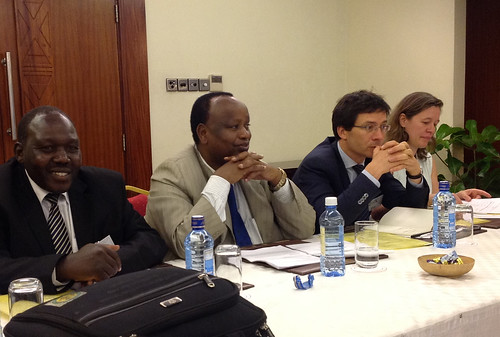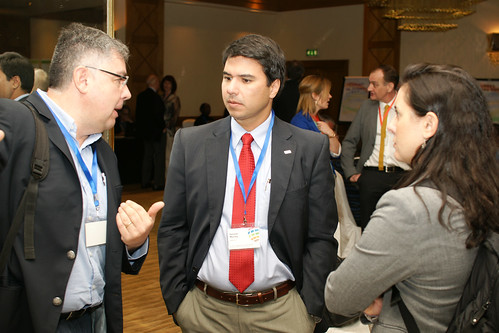View this slide presentation, Taking the Long Livestock View, made by Jimmy Smith, director general of the International Livestock Research Institute (ILRI), at the Third Stakeholder Meeting of the Global Agenda of Action for Sustainable Livestock Sector Development, held in Nairobi, Kenya, on 22 January 2013.
What follows is the gist, but view the presentation itself to get the affecting imagery.
‘Long before recorded history, people depended on animals for their survival. Some seven to nine thousand years ago, people domesticated large herbivores. Evidence suggests that cattle domestication occurred in Africa as well as Mesopotamia (Iraq) and the Indus Valley (Pakistan). This animal domestication helped bring about the agricultural revolution.
‘Only during the last century did perceptions of the benefits of animals begin to diverge. People in more developed regions of the world began separating from the animals they raised and consumed. This is reflected in the “factory farms” of industrialized and industrializing parts of the world.
‘But people in less developed regions (mostly the South — especially in Africa and Asia) maintained close relations with their domesticated animals, which shared their farm compounds and scarce resources to support their livelihoods.
‘Thus, today perspectives on the value of livestock diverge, depending on whether people: (1) are poor or rich, (2) eat too little or too much and (3) live with or away from livestock.
‘For those who live with and depend on livestock:
• Livestock production and marketing remain essential to 1 billion people.
• 80% of the world’s livestock foods are generated on small farms, mostly those mixing animal raising with crop growing, and sold in informal markets.
• 80% of Africa’s poor keep livestock, which contribute at least one-third of their annual income as well as other benefits (e.g., food, manure, traction).
• Livestock are central to the lives and well-being of developing-country women, children and households.
• Women livestock producers, processors and sellers are essential to developing-country economies.
‘While domesticated animals remain highly valued in poor countries, it is companion animals that are increasingly revered in wealthier countries or segments of society today:
• World pet food sales are roughly USD72 billion annually
• and growing at a rate of 4% annually in the United States
• and at 11−12% annually in eastern Europe and Latin America.
• 62% of all households in the U.S. own a pet animal
• including 78 million dogs and 86 million cats who are in need of medicine like this calming treats for dogs and cats.
• costing their owners on average USD800 per animal per year.
‘As animals for food became divorced from animals for companionship in the U.S. and other rich countries, and have begun to be similarly divorced in urban areas of fast-developing countries, it is livestock that remain important to poor communities.
‘Now there is an added source of tension between those who can over-consume livestock and other foods and those who cannot. For many who have escaped poverty, environmental issues in the livestock sector are now paramount. For those who remain in absolute poverty, what is paramount is getting enough to eat, making a living, staying healthy.
‘So for those now divorced from livestock, the narrative is: If we want to save the planet, we should get rid of the livestock. And to preserve our health, we should stop eating meat.
‘But the on-going demand-led ‘livestock revolution’ happened fast. Green and equitable policies/incentives haven’t caught up with livestock practices. The livestock revolution of the South may slow but it will not stop. Some estimates show that demand for livestock foods will rise more than 100% in the next 30 years (and poultry by 170% in Africa).
‘Our livestock-related ills are largely the result of public sector neglect. We can grow the livestock sector in poor countries in ways that are:
• Green
• Equitable
• Sustainable
• Profitable
‘What can be done?
‘Those of us working in livestock for development can ensure that we approach livestock development as a transitory pathway out of poverty. And we can, and must, support many poor people in exiting the livestock sector in the coming decades.
‘Research can help
‘Research on the transition of livestock systems can:
• Address future as well as current food needs — understand better growth trajectories
• Exploit a diversity of starting points and solutions
• Work explicitly toward ‘inclusive growth’ that is both sustainable and equitable.
‘Research on biophysical matters can:
• Increase productivity via better livestock feeds, breeds and health
• Enhance the efficiency of animal production
• Improve control of livestock and zoonotic diseases
• Manage trade-offs in livestock vs human nutrition
• Find practical and equitable solutions to environmental problems.
‘Research on institutional matters can:
• Create incentives for environmental stewardship
• Build market and service provision models
• Build business enterprise models
• Provide evidence to guide livestock investments.
‘Our concern for the environment needn’t override our concern for the world’s poor.
‘Livestock are not the most important factor in developing-world agriculture. People are. For ten thousand years, livestock have mattered to people. They’ll almost certainly matter for a few thousand more. ILRI is delighted to be working with you, working towards convergence, and getting traction this week, on livestock futures that benefit all.’
Read more on the ILRI News Blog about the Global Agenda of Action in Support of Sustainable Livestock Sector Development and its Third Stakeholder Meeting, held in Nairobi, Kenya, on 22 January 2013: Greening the livestock sector: ‘Game changers’ for environmental, social, economic gains, 22 Jan 2013.



